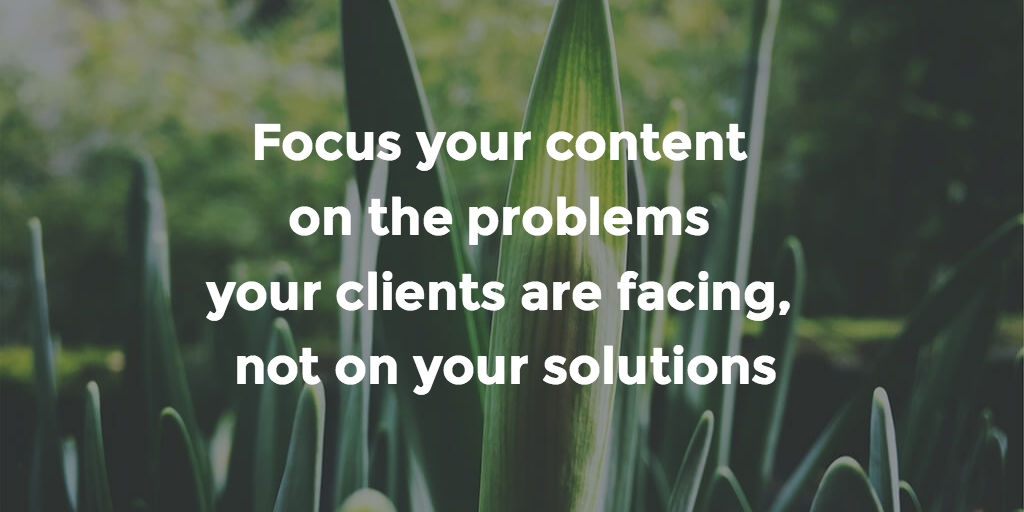Mostly, that means problems. I’ve gone into the question of how to motivate your prospects to take action through “greed” and “fear” in Post #24. While problems (“fear”) and opportunities (“greed”) are both motivators, I find that fear is better at moving people to take action. Ghame theory concurs – people will pay more to avoid a problem (such as the possible loss of $100) than they will to gain an opportunity (the chance to gain $100).
Why you need to start with the problem
Here’s how that works for you, and it goes right back to sales theory. In a past life, I sold office equipment such as photocopiers. In sales training, we were taught to sell on the basis of “feature – advantage – benefit.” As in, “This feature is the ON button. Its advantage is that it allows you to turn the machine on and off. The benefit is that you will feel reassured that you are in control of the equipment.”
That was then, this is now. The buyer is most interested in what your proposed solution can do to solve her or his problems. So, the sales process must begin by understanding the client’s problem or desired situation, goes on to determining what are the consequences of that problem, and then discusses possible solutions. It’s feature-advantage-benefit, only in reverse order. Your content should mirror the buying process.
As an example of this, I recently worked with a client in Houston TX who helps clients in the oil and gas sector avoid operational problems with their pipelines. One of the biggest problems in gas pipelines, they said, comes from the large share of gas now flowing from shale formations.
One of the characteristics of shale gas, my client in Houston said, is that it’s very rich in liquids – methanes and butanes in particular. That’s good in that these natural gas liquids (NGLs) fetch a very healthy price at market. It’s also bad in that liquids in the pipeline tend to plug up the pipeline, particularly at low spots. This over-works the pumps and causes potential for explosions and leaks.
So, the problem is that NGLs are plugging up pipelines. The consequences include higher operating costs, lower pump lifespan, and higher risks due to leaks and catastrophic failures.
The solution, according to my client? Pigging -- lots and lots of pigging, particularly automated pigging. What’s that, you say? Well, a “pig” in this context is a device that’s generally a sphere, nearly the diameter of the pipeline, fed into the line and moved along by pipeline pressure, to clear out the NGLs. So, pigging means inserting these devices into pipelines to keep them clear.
More pigging means higher costs, but also more revenue because of recovery of those precious NGLs. Automated devices allow pigging to be done more often, and without exposing workers to potential dangers from gas venting to atmosphere (as well as the environmental effect of all those methane emissions).
I worked with this client to publish an article along those lines in a UK-based global publication for gas pipeline operators. Yes, this publication exists. It’s a bowl of snore for anyone outside the field, but believe me that there are enough readers with high spending ability, to make it worth publishing. The article covered three pages, and to buy three pages in this publication as advertising would cost over US$16,000. To learn more about how to publish articles in niche publications, see Post #18.
Call it “problem – consequences – solutions”
I saw some of this in a presentation by Sol Orwell, the public face of Examine.com, which provides authoritative, well-researched medical advice. I saw his presentation to Toronto Internet Marketers, a group of enthusiastic entrepreneurial types meeting in the “cool” part of Toronto who have scorned the 9 to 5, working for The Man, and a steady paycheck.Sol made the point that he founded the company on problems – the problems faced by medical professionals and members of the public interested in medical issues. Sol said he doesn’t produce a piece of content, such as a blog post, unless it is in response to a real problem or an in issue.
You can do this for your clients too. But you’re not looking for garden-variety problems found on CNN. You’re looking for consequences for your clients in what I call “narrowcast” news – news that will be relevant to the niche markets you want to serve. I’ve gone into the idea of “newsjacking” in Post #6 – writing about news that will affect people in your market, and giving your recommendations on how to avoid a problem or gain a benefit.
Your value-add comes through the problems you find in that news – problems that will affect your clients. If there’s a new environmental regulation, see if it will increase costs or divert employees’ time towards the steps needed to comply. If there’s a new technology, see if it’s a threat to your clients. If it’s a change in the price of a basic commodity – such as natural gas – think of how it will affect people in your market.
So, don’t start your content with your “features” – your “here’s what I do for my clients” message. Start by asking questions, specifically questions that will uncover problems to be faced by the people you want to serve. Then, the content you create is more likely to match the actual needs – and you’ll then have a chance to meet your clients’ concerns.


